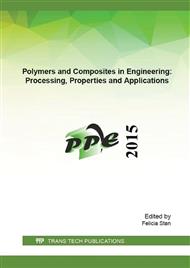[1]
R. Asthana, A. Kumar, N.B. Dahotre, Materials processing and manufacturing science, Edited by Butterworth-Heinemann, London, (2006).
Google Scholar
[2]
C.M. Praveen Kumar, T.V. Venkatesha, K.G. Chandrappa, Effect of surfactants on co-deposition of B4C nanoparticles in Zn matrix by electrodeposition and its corrosion behavior, Surf. Coat. Technol. 206 (2012) 2249-2257.
DOI: 10.1016/j.surfcoat.2011.09.075
Google Scholar
[3]
H.B. Muralidhara, Y. Arthoba Nayaka, J. Balasubramanyam, K. Yogesh Kumar, H. Hanumanthappa, M.S. Veena, Electrodeposition of Zn–Graphite nanoparticles composite and their characterization, J. Chem. Pharm. Res. 4 (2012) 440-449.
Google Scholar
[4]
Y. Reyes-Vidal, R. Suarez-Rojas, C. Ruiz, J. Torres, Ş. Ţălu, A. Méndez, G. Trejo, Electrodeposition, characterization and antibacterial activity of zinc/silver particle composite coatings, Appl. Surf. Sci. 342 (2015) 34-41.
DOI: 10.1016/j.apsusc.2015.03.037
Google Scholar
[5]
P.I. Nemes, M. Lekka, L. Fedrizzi, L.M. Muresan, Influence of the electrodeposition current regime on the corrosion resistance of Zn–CeO2 nanocomposite coatings, Surf. Coat. Technol. 252 (2014) 102-107.
DOI: 10.1016/j.surfcoat.2014.04.051
Google Scholar
[6]
B.M. Praveen, T.V. Venkatesha, Electrodeposition and properties of Zn-nanosized TiO2 composite coatings, Appl. Surf. Sci. 254 (2008) 2418-2424.
DOI: 10.1016/j.apsusc.2007.09.047
Google Scholar
[7]
K. Vathsala, T.V. Venkatesha, Zn–ZrO2 nanocomposite coatings: Elecrodeposition and evaluation of corrosion resistance, Appl. Surf. Sci. 257 (2011) 8929-8936.
DOI: 10.1016/j.apsusc.2011.05.067
Google Scholar
[8]
O. Sancakoglu, O. Culha, M. Toparli, B. Agaday, E. Celik, Co-deposited Zn-submicron sized Al2O3 composite coatings: Production, characterization and micromechanical properties, Mater. Des. 32 (2011) 4054-4061.
DOI: 10.1016/j.matdes.2011.03.027
Google Scholar
[9]
S. Bindiya, S. Basavanna, Y. Arthoba Naik, Electrodeposition and corrosion properties of Zn-V2O5 composite coatings, J. Mater. Eng. Perform. 21 (2012) 1879-1884.
DOI: 10.1007/s11665-011-0099-6
Google Scholar
[10]
K. Kondo, A. Ohgishi, Z. Tanaka, Electrodeposition of Zinc - SiO2 composite, J. Electrochem. Soc. 147 (2000) 2611-2613.
DOI: 10.1149/1.1393577
Google Scholar
[11]
X. Bai, H. Tran, D. Yu, A. Vimalanandan, X. Hu, M. Rohwerder, Novel conducting polymer based composite coatings for corrosion protection of zinc, Corros. Sci. 95 (2015) 110-116.
DOI: 10.1016/j.corsci.2015.03.003
Google Scholar
[12]
D. Vasilakopoulos, M. Bouroushian, Electrochemical codeposition of PMMA particles with zinc, Surf. Coat. Technol. 205 (2010) 110-117.
DOI: 10.1016/j.surfcoat.2010.06.011
Google Scholar
[13]
O. Kammona, K. Kotti, C. Kiparissides, J.P. Celis, Synthesis of polymeric and hybrid nanoparticles for electroplating applications, J. Electrochim. Acta 54 (2009) 2450-2457.
DOI: 10.1016/j.electacta.2008.05.017
Google Scholar
[14]
A. Hovestad, R.J.C.H.L. Heesen, L.J.J. Janssen, Electrochemical deposition of zinc–polystyrene composites in the presence of surfactants, J. Appl. Electrochem. 29 (1999) 331-338.
Google Scholar
[15]
D. Koleva, N. Boshkov, G. Raichevski, L. Veleva, Electrochemical corrosion behavior and surface morphology of electrodeposited zinc, zinc-cobalt and their composite coatings, Trans. Inst. Met. Finish. 83 (2005) 188-193.
DOI: 10.1179/002029605x61676
Google Scholar
[16]
P. Petrov, M. Bozukov, Ch.B. Tsvetanov, Innovative approach for stabilizing poly(ethylene oxide)-b-poly(propylene oxide)-b-poly(ethylene oxide) micelles by forming nano-sized networks in the micelle, J. Mater. Chem. 15 (2005) 1481-1486.
DOI: 10.1039/b417563h
Google Scholar
[17]
L. Benea, M. Mardare-Pralea, Electrodeposition of UHMWPE particles with cobalt for biomedical applications, Dig. J. Nanomater. Bios. 6 (2011) 1025-1034.
Google Scholar
[18]
R. A. Flinn and P. K. Trojan, Engineering Materials and Their Applications, 4th ed., Houghton Mitffllin Co., Boston, (1990).
Google Scholar
[19]
M.R.H. de Almeida, E.P. Barbano, M.F. de Carvalho, P.C. Tulio, I.A. Carlos, Copper–zinc electrodeposition in alkaline-sorbitol medium: Electrochemical studies and structural, morphological and chemical composition characterization, Appl. Surf. Sci. 333 (2015).
DOI: 10.1016/j.apsusc.2015.02.005
Google Scholar
[20]
M.F. de Carvalho, I. A. Carlos, Zinc electrodeposition from alkaline solution containing trisodium nitrilotriacetic added, Electrochim. Acta, 15 (2013) 229-239.
DOI: 10.1016/j.electacta.2013.09.136
Google Scholar
[21]
S. Ranganatha, T.V. Venkatesha, K. Vathsala, M.K.P. Kumar, Electrochemical studies on Zn/nano-CeO2 electrodeposited composite coatings, Surf. Coat. Technol., 208 (2012), 64-72.
DOI: 10.1016/j.surfcoat.2012.08.004
Google Scholar
[22]
X. Xia, I. Zhitomirsky, J.R. Mc Dermid, Electrodeposition of zinc and composite zinc–yttria stabilized zirconia coatings, J. Mater. Proc. Technol. 209 (2009) 2632-2640.
DOI: 10.1016/j.jmatprotec.2008.06.031
Google Scholar
[23]
D.A. Koleva, N. Boshkov, V. Bachvarov, H. Zhan, J.H.W. de Wit, K. van Breugel, Application of PEO113–b-PS218 nano-aggregates for improved protective characteristics of composite zinc coatings in chloride-containing environment, Surf. Coat. Technol. 204 (2010).
DOI: 10.1016/j.surfcoat.2010.04.043
Google Scholar
[24]
N. Boshkov, N. Tsvetkova, P. Petrov, D. Koleva, K. Petrov, G. Avdeev, Ch. Tsvetanov, G. Raichevsky, R. Raicheff, Corrosion behavior and protective ability of Zn and Zn–Co electrodeposits with embedded polymeric nanoparticles, Appl. Surf. Sci. 254 (2008).
DOI: 10.1016/j.apsusc.2008.03.013
Google Scholar
[25]
M. Stern, A. Geary, Electrochemical Polarization: I. A theoretical analysis of the shape of polarization curves, J. Electrochem. Soc. 104 (1957) 56-63.
DOI: 10.1149/1.2428473
Google Scholar
[26]
N. Jadhav, C.A. Vetter, V.J. Gelling, The effect of polymer morphology on the performance of a corrosion inhibiting polypyrrole/aluminum flake composite pigment, J. Electrochim. Acta 102 (2013) 28-43.
DOI: 10.1016/j.electacta.2013.03.128
Google Scholar


